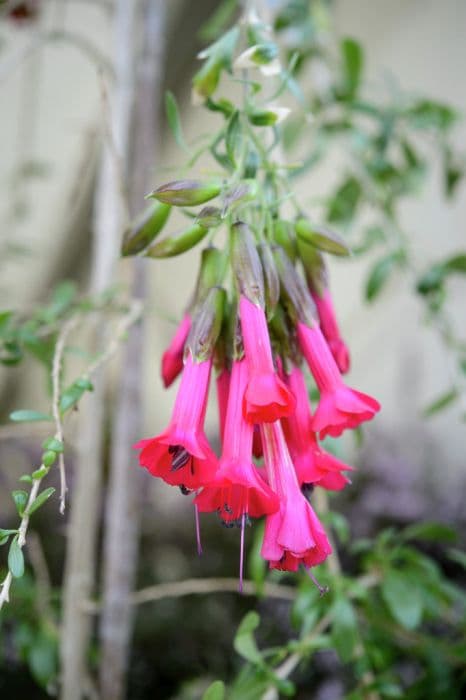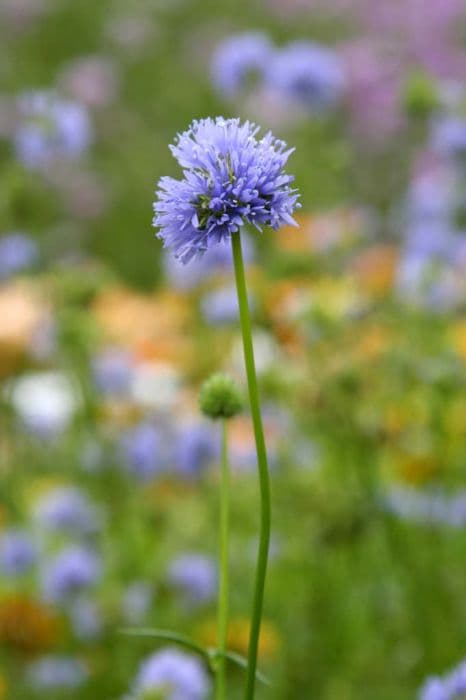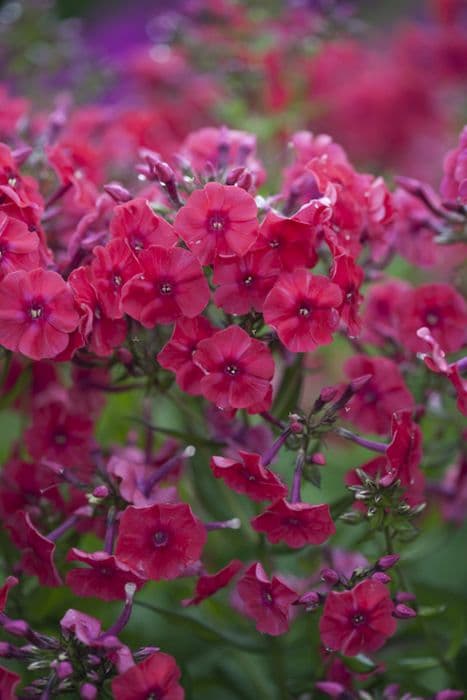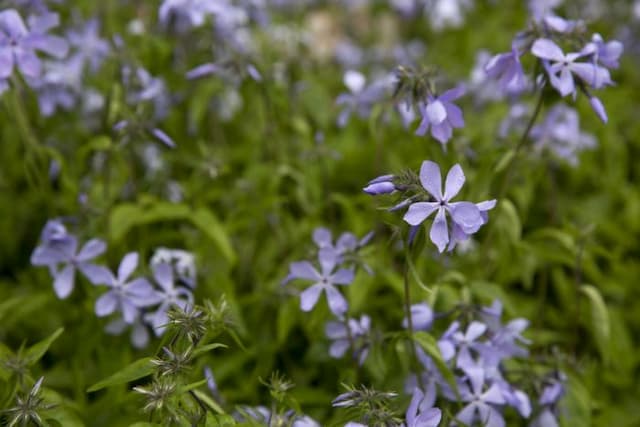Moss Phlox Phlox subulata 'Emerald Cushion'

ABOUT
Phlox subulata 'Emerald Cushion', also known as moss phlox or creeping phlox, is a lush evergreen perennial that forms a dense ground-hugging mat. Its appearance is characterized by a mass of small, needle-like leaves that are bright green in color, creating a soft, emerald-like carpet. During the blooming period, the plant becomes a vibrant spectacle as it is densely covered in a profusion of flowers. The blooms of the 'Emerald Cushion' variety are typically a dazzling shade of pink, with each small, five-petaled flower creating a striking contrast against the green foliage beneath. The blooms are not only remarkable for their color but also for their sheer abundance, enveloping the plant in a cushion of floral beauty that resembles a sea of pink when seen from afar. These flowers are loved by pollinators such as bees and butterflies, adding another layer of dynamism to the plant's presence in the garden. Even when not in bloom, the moss phlox offers year-round interest with its evergreen foliage, contributing texture and color to the landscape.
About this plant
 Names
NamesFamily
Polemoniaceae.
Synonyms
Creeping Phlox, Moss Phlox, Moss Pink, Mountain Phlox, Flowering Moss.
Common names
Phlox subulata 'Emerald Cushion Blue', Phlox subulata 'Emerald Blue'
 Toxicity
ToxicityTo humans
Moss Phlox is not known to be toxic to humans. Ingesting any part of this plant typically does not result in poisoning or adverse health effects.
To pets
Moss Phlox is not known to be toxic to pets. Ingesting any part of this plant typically does not result in poisoning or adverse health effects for pets such as dogs and cats.
 Characteristics
CharacteristicsLife cycle
Perennials
Foliage type
Evergreen
Color of leaves
Green
Flower color
Pink
Height
6 inches (15 cm)
Spread
2 feet (60 cm)
Plant type
Creeper
Hardiness zones
3
Native area
North America
Benefits
 General Benefits
General Benefits- Attracts pollinators: Phlox subulata 'Emerald Cushion', commonly known as Moss Phlox, attracts bees and butterflies, providing essential support for local ecosystems.
- Low maintenance: Once established, Moss Phlox is drought-tolerant and requires minimal care, making it ideal for gardeners looking for low-effort plants.
- Ground cover: Its mat-forming growth habit makes it excellent for covering bare spots and controlling erosion on slopes and banks.
- Extended blooming: Moss Phlox offers a long flowering period, with vibrant blossoms typically lasting from early spring into summer.
- Color variety: It comes in a range of colors, adding visual interest and versatility to garden designs and landscapes.
- Winter interest: The evergreen foliage of Moss Phlox provides color and texture in the winter garden when most plants are dormant.
- Deer resistance: Moss Phlox is generally resistant to deer, helping to prevent damage to the plant and maintaining its aesthetic appeal.
- Easy propagation: It can easily be propagated through cuttings or division, allowing gardeners to expand their displays without additional cost.
- Suitability for containers: Moss Phlox can thrive in containers, making it a good option for those with limited space or who prefer container gardening.
- Tolerance of poor soil: It can grow in poor or rocky soil, which is beneficial for planting in challenging garden spots where other plants may struggle.
 Medical Properties
Medical PropertiesThis plant is not used for medical purposes.
 Air-purifying Qualities
Air-purifying QualitiesThis plant is not specifically known for air purifying qualities.
 Other Uses
Other Uses- Photography prop - Moss Phlox, with its vibrant flowers, can serve as a picturesque foreground or background in garden photography, enhancing the aesthetic appeal of the photos.
- Erosion control - The dense mat-like growth habit of Moss Phlox helps stabilize soil on slopes and hillsides, preventing soil erosion.
- Landscape design - Moss Phlox can be used as a living edge or border to define paths and garden areas due to its compact growth.
- Aquarium decoration - When dried properly, Moss Phlox can be used to add natural elements to aquarium landscapes for a splash of color.
- Education - Moss Phlox is an excellent plant for teaching children about plant propagation, as it can be easily divided and grown from cuttings.
- Culinary decoration - Although not commonly consumed, the flowers can be used as edible decor for salads and desserts after proper verification for non-toxicity.
- Art and crafts - Pressed Moss Phlox flowers can be used for creating bookmarks, greeting cards, or other paper crafts.
- Green roofing - Moss Phlox can be used in green roofing projects due to its low maintenance and drought resistance, providing an attractive and eco-friendly roof cover.
- Floral arrangements - Fresh or dried Moss Phlox flowers can add a splash of color to floral arrangements or potpourris.
- Fairy gardens - Moss Phlox's compact size and lush looks make it perfect for creating whimsical fairy garden landscapes.
Interesting Facts
 Feng Shui
Feng ShuiThe plant Creeping Phlox is not used in Feng Shui practice.
 Zodiac Sign Compitability
Zodiac Sign CompitabilityThe plant Creeping Phlox is not used in astrology practice.
 Plant Symbolism
Plant Symbolism- Harmony - Phlox subulata, commonly known as Moss Phlox, symbolizes harmony because of how it spreads and creates a unifying carpet of color when in bloom.
- Agreement - Moss Phlox's growth habit is not aggressive or overpowering, making it a symbol of agreement and gentle expansion in garden spaces.
- Unity - With its interlocking stems and flowers, Moss Phlox visually represents unity, as it brings together various elements of the garden in a cohesive manner.
- New Beginnings - The blossoming of Moss Phlox in springtime represents new beginnings and the renewal of life.
- Calmness - The soft and cushiony appearance of Moss Phlox imparts a sense of calm, providing a visual representation of tranquility in the landscape.
 Water
WaterCreeping Phlox, or Moss Phlox, needs regular watering, particularly during hot, dry periods. Water the plant thoroughly once a week, providing about one inch of water which roughly translates to 0.6 gallons per square yard of soil. Ensure the water penetrates the soil to reach the roots rather than just wetting the surface. During the spring and early summer growth period, maintain consistent moisture but allow the soil to dry out slightly between waterings. Decrease frequency in cooler months, and be cautious not to overwater, which can lead to root rot.
 Light
LightCreeping Phlox thrives best in full sun, meaning it should receive at least six hours of direct sunlight daily. The ideal spot for planting is an area with clear, unfiltered sunlight, although it can tolerate partial shade. However, too much shade can reduce blooming and can lead to leggy growth, so it's best to ensure ample light for healthy development and vibrant flowers.
 Temperature
TemperatureCreeping Phlox is hardy and can survive a range of temperatures, enduring minimum temperatures as low as negative 20 degrees Fahrenheit. While it can withstand cold winters, it grows best in temperatures between 60 and 70 degrees Fahrenheit. It can handle summer heat quite well but will need extra water during particularly hot spells to stay healthy.
 Pruning
PruningPruning Creeping Phlox is essential for encouraging a dense growth habit and maintaining the plant's appearance. Pruning should occur immediately after the flowering period ends, which is often in late spring or early summer. Cut back the foliage to about one to two inches above ground level; this will encourage fresh growth and prevent the center of the plant from becoming woody and bare. Regular pruning also helps to minimize the risk of fungal diseases by improving air circulation.
 Cleaning
CleaningAs needed
 Soil
SoilMoss Phlox requires well-drained soil with a mixture of loam, sand, and compost to thrive. A soil pH of 6.0 to 8.0 is suitable for this plant, ideally leaning towards a slightly alkaline range. To achieve the best mix, combine one part sand, one part compost, and two parts garden loam.
 Repotting
RepottingMoss Phlox is typically not repotted often, as it is a ground cover plant that spreads outwards. Repotting or dividing might only be necessary every few years to rejuvenate overcrowded clusters and encourage more vigorous growth.
 Humidity & Misting
Humidity & MistingMoss Phlox prefers average humidity conditions and does not require high humidity to flourish. It will do well in the ambient outdoor humidity levels found in most temperate climates where it is commonly grown.
 Suitable locations
Suitable locationsIndoor
Provide ample light and good air circulation for Moss Phlox indoors.
Outdoor
Plant in well-drained soil, full sun, and space 15-18 inches apart.
Hardiness zone
3-9 USDA
 Life cycle
Life cyclePhlox subulata 'Emerald Cushion', commonly known as Creeping Phlox or Moss Phlox, begins its life as a seed, which germinates under favorable conditions typically in spring. The seedling stage follows, with young plants developing true leaves and a root system. In the vegetative stage, Creeping Phlox spreads out to form low, mat-like foliage, rooting at the nodes and covering the ground. Once mature, it enters the reproductive stage, producing masses of vibrant, five-petaled flowers in early to late spring, attracting pollinators. After flowering, it sets seed, completing its annual reproductive cycle, though the plant itself is a perennial and will continue this cycle for several years. In the final stage, after many seasons, the plant may eventually die back, with older parts of the mat dying off and new plants forming from the rooted nodes.
 Propogation
PropogationPropogation time
Spring-Early Summer
The most popular method of propagating Phlox subulata 'Emerald Cushion', also known as moss phlox, is through stem cuttings. To propagate moss phlox using stem cuttings, one should ideally undertake the process in late spring or early summer when the plant is actively growing. Select a healthy, non-flowering stem and make a cut to create a cutting around 4 to 6 inches (about 10 to 15 centimeters) long. After cutting, remove the leaves from the lower half of the cutting and dip the cut end into a rooting hormone to encourage root development. Then, plant the cutting in a well-draining soil mix, ensuring that the node where the lower leaves were removed is buried. The cutting should be kept moist and in a location with indirect sunlight. Roots typically develop within a few weeks, after which the young plant can be transplanted into the garden.









